How to retain employees during the Great Resignation?
After 2021, many recruiters literally felt an earthquake seeing their employees massively leaving. This natural disaster called Great Resignation left us no choice except to learn from previous mistakes and build a more solid foundation for HR management.
Nothing comes without a reason, right? So why do people quit?
Influenced by the wave of the Great Resignation, employees started to rethink where, how, and why they work. Now, for more people simply giving a paycheck is not enough anymore, especially when we talk about hiring experts with demanded skills.
Some employers doubt and ask: is the Great Resignation still happening?
Yes. Data shows that 6 out of 10 U.S. employees consider quitting in 2023, regardless of recession fears and extensive hiring freezes. What can you do with all that?
Here are 5 practical steps to help you feel not so clunky in the new realm. So let’s go.
1. Identify your weaknesses
Some industries were hit by the Great Resignation more than others. But there are common things among them all.
It’s no secret that most people quit due to low salaries. This factor pushed 61% of people to seek a new job. But it’s not the only one.
For about a third of the workforce, the lack of benefits & perks was a decisive factor. That group is followed by people (36%) whose employers don’t allow them to work remotely or on a hybrid basis.
LinkedIn and Zippia also pointed out that employees expect career growth and more respect at work. And how do you strike the right balance with all these arising needs?
Before you type a new corporate policy against the Great Resignation, consider that the large numbers can miss out on your internal employment problems.
That’s why to take the right actions, analyze what triggers your staff to leave. Assessing some quantitative parameters may be useful, for example:
- compensation
- the size of pay increases
- the time between promotions
- KPI
- number of training opportunities
Checking this data, you might find a correlation between layoffs and people policies. Some categories of workers may tend to quit more often than others. For example, resignation rates can be higher among mid-career employees.
After you’ve dug deep into numbers, you can draft a robust retention program.
2. Lead changes
When you have a glimpse of your employees’ expectations, try to sketch out the main points of your retention program. Don’t know where to start? You’re in the right place, just look at the list below.
- Fair compensation
Rightly so, money motivates people. But if a company is passing through financial difficulties, you can’t always guarantee raises. However, you can use another trump card. The equitable distribution is no less appreciated by staff.
It works like that: each person receives the same amount relative to others' contributions. Following this strategy, you don’t have to apply absolute parity across all members of a group. If one worker produces twice as much output as another worker, he or she gains extra compensation.
- Remote work
The Great Resignation made it clear: employees expect more flexibility at work. If remote work is not about your company, we have some data that might change your mind.
Applying work-from-home is one of the most common ways to make your employees feel happier and more engaged in their jobs. According to Owl Labs and Global Workplace Analytics, 74% of employees feel more satisfied when they work remotely. Still not sure? Consider the next fact.
Seeking an elusive work-life balance, workers don’t want to lose such luxury as remote work whatever it takes. Statistically speaking, 45% of remote employees would leave if they would be asked to get back to an office.
By the way, think ahead. Your future candidates will double-check if you stick to the WFH model.
.jpeg)
- Poor communication
The Great Resignation revealed that employees want to feel more valued and connected to a group’s achievement. Maybe you have exciting business goals or a resonating idea for the next quartal. So share it!
Don’t keep the thrilling news only for executive meetings. Make your team inspired as well. Such communication will truly help to reset after everyday struggles and get a second wind.
Again, the communication plan won’t work out if it’ll seem more like a dry corporate policy than a team play. First and foremost, your employees expect to feel heard.
In a dialogue, you can show that their contributions matter. Going through the conversation, don’t hesitate to hit your managerial targets and align their efforts with the company’s goal.
- Career pathing
One of the predictors of attrition during the Great Resignation is the lack of career planning for employees. Resigners often expect clear opportunities for professional growth.
Monster reports that 80% of employees think their current employer doesn’t offer options for growth. And it’s a deadly mistake.
Check out the article to take the first steps in upskilling your employees.
This movement is particularly relevant to tech-savvy millennials and Generation Z. 74% of them would be more likely to quit missing self-actualization at the workplace.
- Healthy work culture
No wonder any disrespect or tense micromanagement prompts employees to leave. And by contrast, a positive working environment would help you retain about 43% of your staff. However, a healthy workplace won't appear overnight.
To get started, let’s try to view your organization through the eyes of your employees and spot signals of a toxic culture. The strongest factors pushing employees out the door include:
- Lack of consideration, courtesy, and dignity
- Non Inclusive culture
- Unethical behavior (dishonesty and lack of regulatory compliance)
- Tight internal competition (uncooperative teammates)
- Lack of coordination across organizational silos
Do you have one or several symptoms? Take heart, you still can detox your corporate culture. Try to start with the management.
- Strong management
During turbulent times of Great Resignation, managers play critical roles. The way leadership behaves often influences the employees’ decision to stay or leave.
To earn the employees’ trust, companies bet on the improvement of managers’ skills. For instance, you may offer your managers to join leadership or project management courses. That will ensure you align your management with the external realm and trends.
Conclusion
As you can see, there are many reasons why employees want to quit during the Great Resignation. If you're also facing employee turnover, then try to add more credibility with the tactics mentioned above.
{{quote-text}}









